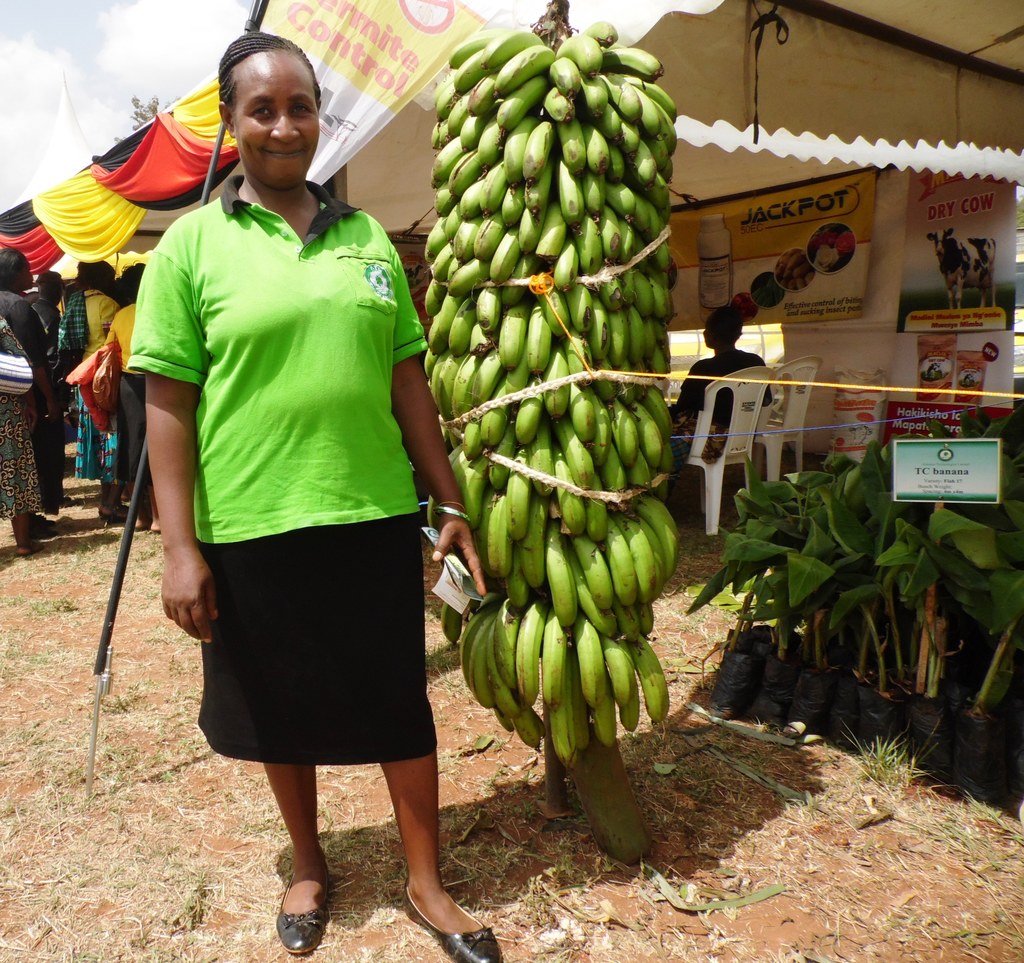Aberdare Technology staff Naomi Wahu stands beside the seedlings firm's giant banana of more than 110kg in Thika on February 17, 2017. Irrigation can increase banana weight by 30 per cent. Photo by Laban Robert.
Farmers, who regularly irrigate bananas, can boot the weight of the fruit by more than 30 per cent.
More than 90 per cent of famers in Kenya- especially in Nyanza and Central regions- do not know bananas have to be irrigated like other horticultural crops for high yields.
That is why some of the biggest bananas only reach 50kg to 80kg- depending on the rains. Naomi Wahu, who had a banana weighing about 110kg during a farmers’ event in Thika in February 2017, said reduced soil moisture affects food conversion in the crop for maximum weight.
A plantlet requires at least 40 liters of water after planting. But as it grows, 20 litres of water must be added to the sucker until maturity,” Wahu, who is a field officer at the Aberdare Technologies Limited said.
In the absence of rains, the banana sucker must get 40 to 60 litres of water every week. However, Wahu warned that excess water encourages rotting of the roots due to clogging.
Bananas have broad leaves, with some spreading to more than two mitres. The leaves offer a large surface area for the loss of water through transpiration. This water, therefore, must be recovered via irrigation in absence of rain.
READ ALSO: Bagging bananas quickens maturity by two weeks
READ ALSO: Chamber halves banana ripening days, doubles group earning
READ ALSO: Super fertilizer that add 10 kilos to banana yields
The seedling propagation firm has repeatedly harvested tissue culture bananas weighing more than 100kg.
These crops require prolonged light exposure hours for quick maturity and finger filling. During pruning, the farmer needs to remove the excess suckers to remain only with those facing the east.
Only three sword suckers should be standing for every stool of bananas-a flowering, ‘teenager’ and an emerging one.
The morning to past midday sun has growth boosting wavelengths that can reduce the maturity days by weeks or a month.
Facing the east also positions the bananas against the currents of strong wind, given that in the tropics it mostly blows towards the west.
A banana plantlet is grown in a 3feet by 3feet hole of about 5feet deep. The plant to plant spacing is three mitres apart.
Two wheelbarrows of farm yard manure and about 200g of double ammonium phosphate are mixed with an anti-nematode dose and top soil.
The plantlet is firmed in the mixture followed by 40 litres of water. The stems must be propped to prevent premature falling due to strong wind.
A fruit is ready for harvest in 12 to 15 months after transplanting.
Kisii, Nyamira, Meru, Nyeri, Nyandarua , Muranga are some of the counties where bananas are commonly grown for commercial and domestic consumption.
Aberdare Technology limited can be reached on +25472581444, +254709333103 or +254709333104.
